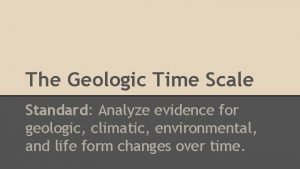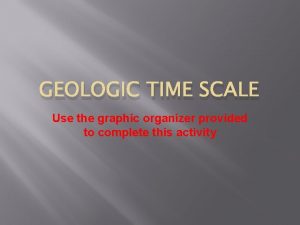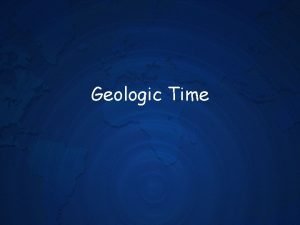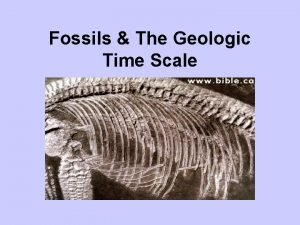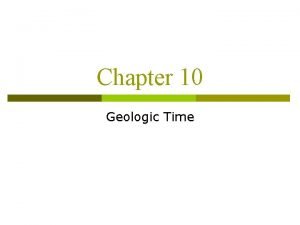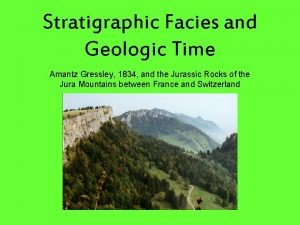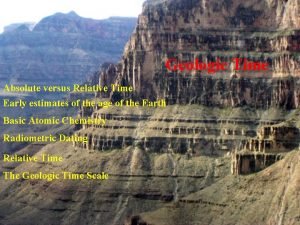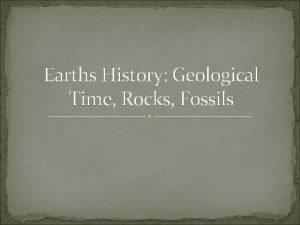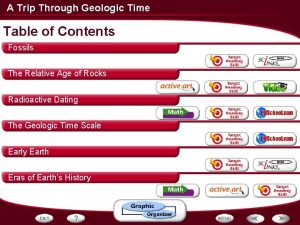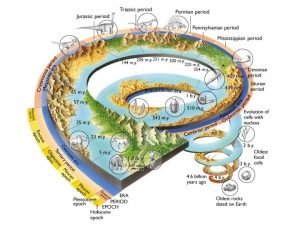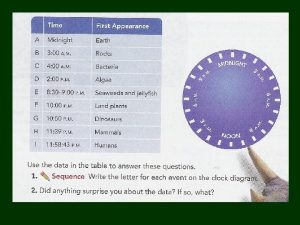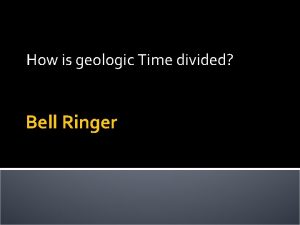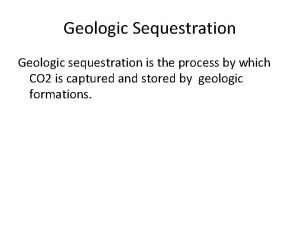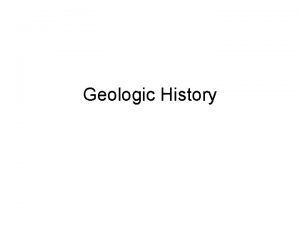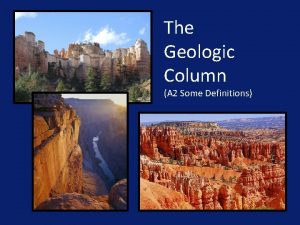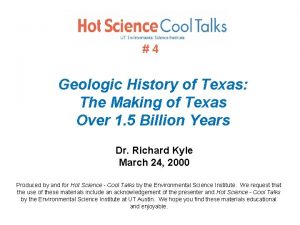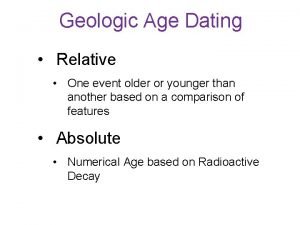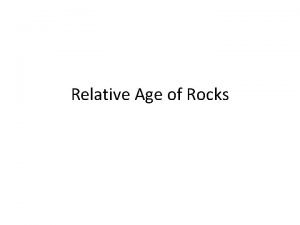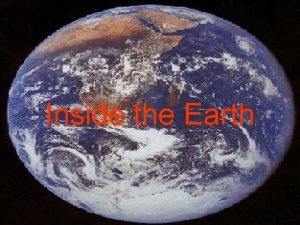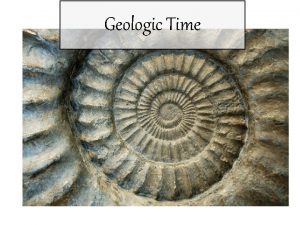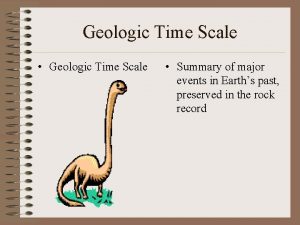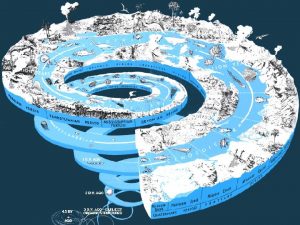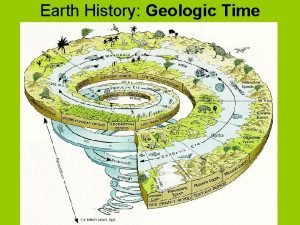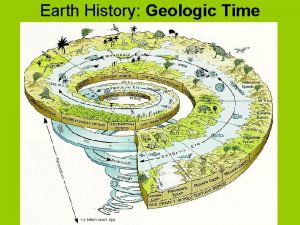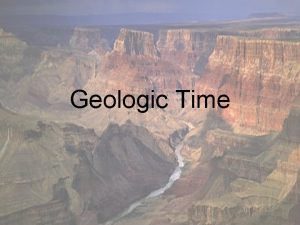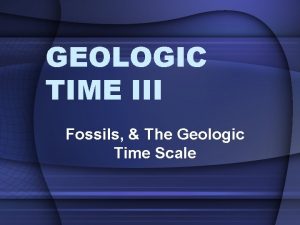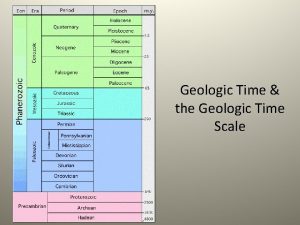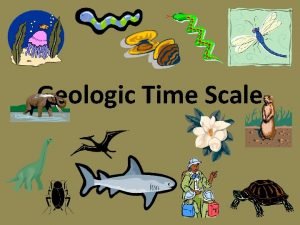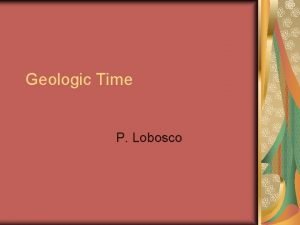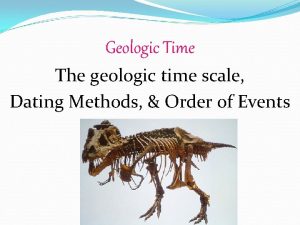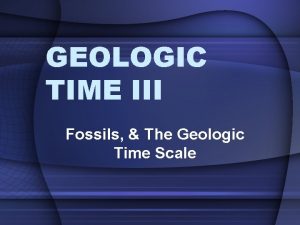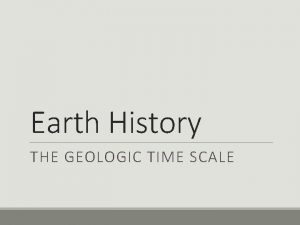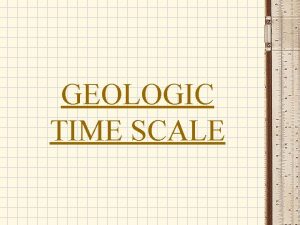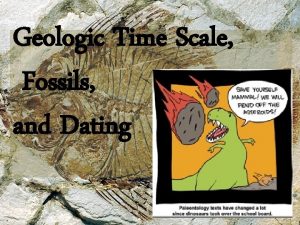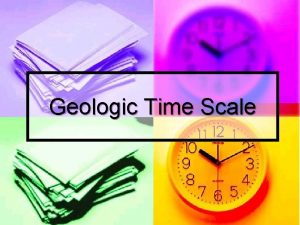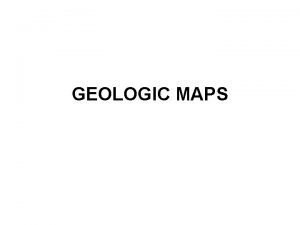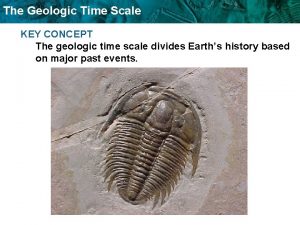The Geologic Time Scale Sections of time ERA































- Slides: 31

The Geologic Time Scale

Sections of time • ERA Two or more geological periods comprise an era, which is hundreds of millions of years in duration.

• PERIOD The period is the basic unit of geological time in which a single type of rock system is formed, lasting tens of millions of years. EPOCH An epoch is a division of a geologic period; it is the smallest division of geologic time, lasting several million years.

• Eon- Era- Period- Epoch- Age. • Humans as we know ourselves appeared in the Pleistocene Epoch of the Quaternary Period in the Cenozoic era of the Phanerozoic Eon…. .

Pre Cambrian time • 4. 6 Billion years ago 542 MA • Earth Forms • Stromatolites are dominant life form

Paleozoic Era • 542 to 251 mya • Multicellular life!!

Paleozoic, Cambrian, • • 488 -542 MA Trilobites dominate many phyla develop. “Cambrian Explosion”

Paleozoic, Ordovician, • 488 to 444 mya • North America is under shallow sea. • Modern Oxygen rich atmosphere develops • Vertebrates Develop

Paleozoic, Silurian • 444 MA 416 MA • First Land Plants and Animals

Paleozoic, Devonian, • 416 MA -359 MA • First amphibians • Age of fishes

Paleozoic, Carboniferius, Missippian • 359 MA – 318 MA • Amphibians Flourish • Forests and swamps cover land

Paleozoic, Carboniferius, Pennsylvanian • 318 MA – 299 MA • Giant flying insects • First Reptiles, ROAR!!

Paleozoic, Permian • 299 MA – 251 MA • Pangea comes together

Mesozoic Era • "The Age of Reptiles" 251 MA to 65. 5 MA

Mesozoic, Triassic • 251 MA – 200 MA • Dinosaurs appear • Mammals appear

• Cycads and conifers dominate

Mesozoic, Jurassic • 200 MA- 146 MA • Dinosaurs are the dominant animal. • Primitive vertebrate flight, first birds

Mesozoic, Cretaceous, • 146 -65. 5 MA • Flowering plants appear (angiosperms) • Modern Birds • All good until……

K-T Extinction • • 65 MA Kills off Dinosaurs Asteroid or volcano Iridium rich dust….

Cenozoic Era "The Age of Mammals" 65. 5 mya through today Continents at present locations


Cenozoic, Tertiary, Paleocene Tertiary 65 -55. 8 mya Paleocene- age on mammals begins First Primates

Cenozoic, Tertiary, Eocene • 55. 8 -33. 9 mya • Rodents appear. Primitive whales appear.

Cenozoic, Tertiary, Oligocene • 33. 9 -23 mya • Dogs and cats appear! • But they did not look like that -

Cenozoic, Tertiary, Miocene • 23 -5. 3 MA • Due to high abundance of grasses, herds of large mammals abound.

Cenozoic, Tertiary, Pliocene • 5. 3 -1. 8 • First hominids (australopithecines). Modern forms of whales. Megalodon swam the seas • Hominid- where humans and apes split


• Lions Tigers and Bears…. • Appear in the Pliocene

Cenozoic, Quauernary, Pleistocene • Quaternary Period "The Age of Man" 1. 8 mya to today • Pleistocene- The Last Ice Age 1. 8 -. 012 ma • Humans (Homo sapien) appear. You better remember this!

• Mammoths, sabertoothed cats,

Quaternary, Holocene • 11, 500 ya to today • Marked by complex human civilization • Ice melted, and sea level rose 140 m!
 Compare geologic time with the geologic column.
Compare geologic time with the geologic column. How is the geologic time scale organized
How is the geologic time scale organized Graphic organizer geologic time scale
Graphic organizer geologic time scale Geologic time calendar
Geologic time calendar Geologic time scale animals
Geologic time scale animals The longest subdivision of the geologic time scale is the
The longest subdivision of the geologic time scale is the Moth scale
Moth scale Geologic time
Geologic time Facies
Facies Geologic time scale poem
Geologic time scale poem Geologic time scale
Geologic time scale Geologic time scale drawing
Geologic time scale drawing Fossils
Fossils Geological time scale graphic organizer
Geological time scale graphic organizer Largest division of geologic time
Largest division of geologic time Geologic time
Geologic time What is the longest subdivision in geologic time
What is the longest subdivision in geologic time Chapter 12 geologic time
Chapter 12 geologic time Era quiz: the baroque era
Era quiz: the baroque era Elizabethan or victorian
Elizabethan or victorian Creí que era una aventura y en realidad era la vida
Creí que era una aventura y en realidad era la vida Era uma estrela tão alta era uma estrela tão fria
Era uma estrela tão alta era uma estrela tão fria Geologic sequestration
Geologic sequestration Geologic history definition
Geologic history definition Geologic column definition
Geologic column definition Geologic history of texas
Geologic history of texas Geologic history
Geologic history Disconformity
Disconformity Relative age
Relative age What is earth made out of
What is earth made out of Cal gem
Cal gem What is a line scale
What is a line scale

